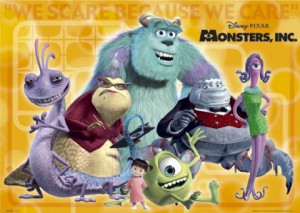Just Make A Movie…
Few people realize the opportunity they have right in front of them. They think some bolt from the blue is going to hit them and change their fortunes forever.
George Lucas recognized his….
“When I was in film school, the big issue was
‘When are we going to get to make a movie?’ …
They gave us 32 feet of 16 mm film which was exactly 1 minute of film … I turned it into a 1-minute movie.
If somebody gave me 100 feet of film … I made a movie out of it. And the other kids basically didn’t. They had the same 100 feet of film. They had the same camera. And, they just said ‘When am I going to get to make a movie?’ And I just kept making them.”
George Lucas
…and the result was
and
What are you going to do with your opportunity today?
5 ½ Reasons Why You Should Include Simulations in Your Hiring and Training Processes
People are your most precious resource. Nobody WANTS to make a mistake in hiring or promotions. When it comes to training Andy Grove, the Intel visionary, said it best, “The most important charge a good manager owns is the responsibility to continuously train his/her employees.”
Below are the 5 ½ reasons why simulations should be an integral part of your hiring, promotion and training processes.
-
The 5 to 1 Ratio
A mis-hire/promote costs the company 5 times the candidate’s annual compensation ($50,000 salary costs the company $250,000).
With training its just as easy to see the ROI. A business parable for you:
CEO said to the CFO ‘We have to train our people to get better.’
CFO says ‘Yea but what if we invest time and money to train them and they leave us to go to our competitor?’
CEO shoots back ‘What if we don’t train them and they stay?’
Whether it is a mis-hire or a less than adequately trained employee the impact on client relations, revenue, productivity, supervision time and morale is negative and it is huge.
-
The Power of Proof
Have you ever had an interview where the person told you they couldn’t do the job? Or have you ever had a person who “stretched” their abilities in the interview and as a result you were cleaning their messes for days, weeks or months after?
A best practice simulation provides you “Point-to-Point Correspondence” with the job. When the activities found in the simulation are a replica of activities that are required on the job, you get an accurate portrayal of skill level.
This is also why simulations are critical to training. Do you really want salespeople “practicing” on customers? Of course you don’t! General George Patton once said “The more my troops sweat in peacetime the less they bleed during combat.” Simulations are a must in all continual development.
-
How do They Handle the Debrief
Once they perform in the simulation how do they respond to constructive criticism? Are they thin-skinned? Do they gloat? Is their self-confidence warranted? Many times, you find out the best and the worst of people by observing how they handle coaching.
It also opens a window to know how they learn best. Through the Debrief you will discover what they will and won’t respond to. This can be invaluable as you continue to train and develop your team.
-
Go to the Video
When recorded, simulations help reduce, if not remove bias and subjectivity in the hiring process in one BIG way, “The eye in the sky does not lie.” You don’t want a he said/she said situation in any business scenario, but especially in simulations.
Here’s a great example of the benefit of recording simulations: A hiring manager who got a ‘good hit’ off a candidate, in an interview, might get a completely different feeling after watching a recorded simulation. The candidate might be the most charming person in the world, but when the time came he didn’t have the skills he trumpeted. In any business, that is a disaster averted.
Recorded simulations are irreplaceable in training as well. There is nothing better than being able to go back and review specific areas for either praise or correction. Plus, reviewing with individuals their recorded progress or regression is a very powerful training tool.
-
Onboarding
Even if somebody is an A-Player it does not mean they are perfect. Too many onboarding programs fail to adapt to the candidate, thus slowing the speed to effectiveness of the new hire.
Simulations don’t just weed out bad candidates. They also help you to assess a good candidate’s specific strengths and weaknesses in a hyper-accurate way. This allows you to design/implement an onboarding process to speed them to productivity. Not to mention it helps in offer decisions like salary negotiations.
5 ½. Positioning Your Company as the Best
The War for Talent is upon us and there are only so many A-Players out there. The mistake most organizations commit is purposefully making the hiring process easier out of fear of losing the candidate.
Thomas Payne said, “What we obtain too cheap, we esteem too lightly: it is dearness only that gives everything its value.” Being with the BEST requires paying the PRICE. Candidates learn respect for the position and respect for the company by demonstrating how seriously the company takes the hiring process. The best  candidates don’t want to be with some company that just rolls over. Remember everybody wants to belong to The Club that is impossible to get in.
candidates don’t want to be with some company that just rolls over. Remember everybody wants to belong to The Club that is impossible to get in.
87% of people who voluntarily (i.e .Quit) leave a company do so because of a lack of growth and development opportunity. Its human nature to want to improve, to develop new skills, succeed and advance. If you have good people, make them better.
Use simulations to continually train and develop your team. And you know what they call the company with the top employees… they call that company the BEST!
To ensure you are hiring A-Players and for training to be impactful and ‘sticky’ both have to be closely tied to how things are actually done in your organization. This is why simulations are such a critical management tool.
The Right Way to Hold People Accountable
Hi Folks. In my previous blog post, I was talking about holding yourself accountable as a leader. Well ‘lo and behold this article pops up in my email box this morning.
It is a great piece on the topic of accountability and the 5 areas where you must BE CLEAR for real accountability to truly exist. I will be continue digging into this topic as it relates to sales leadership and management as January progresses.
Here is an excerpt from the article and the link to the entire article is below.
- Clear expectations. The first step is to be crystal clear about what you expect. This means being clear about the outcome you’re looking for, how you’ll measure success, and how people should go about achieving the objective. It doesn’t all have to come from you. In fact, the more skilled your people are, the more ideas and strategies should be coming from them. Have a genuinely two-way conversation, and before it’s over, ask the other person to summarize the important pieces — the outcome they’re going for, how they are going to achieve it, and how they’ll know whether they’re successful — to make sure you’re ending up on the same page. Writing out a summary is a good idea but doesn’t replace saying it out loud.
- Clear capability. What skills does the person need to meet the expectations? What resources will they need? If the person does not have what’s necessary, can they acquire what’s missing? If so, what’s the plan? If not, you’ll need to delegate to someone else. Otherwise you’re setting them up for failure.

- Clear measurement. Nothing frustrates leaders more than being surprised by failure. Sometimes this surprise is because the person who should be delivering is afraid to ask for help. Sometimes it comes from premature optimism on both sides. Either way, it’s completely avoidable. During the expectations conversation, you should agree on weekly milestones with clear, measurable, objective targets. If any of these targets slip, jump on it immediately. Brainstorm a solution, identify a fix, redesign the schedule, or respond in some other way that gets the person back on track.
- Clear feedback. Honest, open, ongoing feedback is critical. People should know where they stand. If you have clear expectations, capability, and measurement, the feedback can be fact-based and easy to deliver. Is the person delivering on her commitments? Is she working well with the other stakeholders? If she needs to increase her capability, is she on track? The feedback can also go both ways — is there something you can be doing to be more helpful? Give feedback weekly, and remember it’s more important to be helpful than nice.
- Clear consequences. If you’ve been clear in all of the above ways, you can be reasonably sure that you did what’s necessary to support their performance. At this point, you have three choices: repeat, reward, or release. Repeat the steps above if you feel that there is still a lack of clarity in the system. If the person succeeded, you should reward them appropriately (acknowledgement, promotion, etc.). If they have not proven accountable and you are reasonably certain that you followed the steps above, then they are not a good fit for the role, and you should release them from it (change roles, fire them, etc.).
Link to the rest of the article is right here
The Right Way to Hold People Accountable
Everything I Ever Needed to Know About Sales I Learned From the Movies: Monsters, Inc.
3 Sales Management Lessons From
The Power of Practice
We all think we are sooooo great! Just wind us up, do a little preparation and let’s go talk to customers. Well the scary characters in Monsters, Inc. would tell you different. Scaring is critically important in their world because the “screams” that come from the children they scare power their city, lights, heat, cars you name it.
The first scene in the movie shows their training area where they practice “scaring.” They have a replica child’s room complete with a “little boy” robot. One of the “professional scarers” comes out of the closet to scare the little boy and he makes some serious mistakes. It is prime learning time for the all monsters on the team because they video tape the simulations. Now they can go back and coach/correct all the mistakes. It helps the individual monster making the mistakes and all the other monsters on the team.
Sound familiar? Folks you are making a gravely serious mistake if you do not conduct simulations with your team. Make them as real to life as you possibly can. Video tape them so you can document progress or regression. Make the simulations part of your weekly/monthly/quarterly sales meetings. Make them fun, have contests around them. But most of all DO THEM!
You should also practice presentations with every rep individually. Don’t leave anything to chance. Give your rep the best shot possible by running through the discovery/presentation/negotiation with them BEFORE they go to it. George Patton, one of our greatest generals of all time, said “Sure I am tough on them during training! I much rather they sweat with me than bleed on the battle field.” Well, I rather my sales people learn in an office from me so they are prepared to get the sale, than by learning a lesson with a client and losing the sale.
The Power of Naming
About half-way through the movie there is a scene where the two main characters, Sully and Mike, are trying to send home the little girl who snuck into the Monster’s world. They are arguing about how to do it when Sully says that he has named her “Boo.” Well Mike is just livid at this development and he says, in a very angry voice, “You named it? You can’t name it; once you name it you get attached to it.” Exactly, once we take the time and effort to name something we begin to place value on that something. It is the reason why I tell all my clients that they should name their proposals.
What is special about an ‘Investment Analysis for ABC Company’ or what about ‘A Proposal for Electronic Payment Services Prepared by Joe Smith Company’? Answer: NOTHING. Both sound as generic as the proposal inside, I would wager. That is why I am amazed when sales management does not make formally naming proposals an air tight rule for every proposal that goes out the door.
The proposal is supposed to be a professional selling document not a glorified descriptive invoice. NAME YOUR PROPOSAL based on what the prospect wants as a RESULT of buying your products and services. A couple of examples I have used:
- “How to Improve your Sales Team While Increasing Sales Revenue”
- “Increase the Productivity of your Customer Service Team and Watch your Sales Soar”
- “Creating a Lead Generation System that Produces an Ongoing Stream of Quality, Qualified Leads”
Each one of the above Proposal Names tell the prospect EXACTLY what to expect from reading the proposal but more importantly each name tells THE VALUE that comes from implementing what is inside the proposal.
The Power of Laughter
Remember when I told you that a child’s scream was the source for power in Monster City? Well by the end of the movie Sully and Mike learn that laughter is 10 times more powerful than a scream so they completely re-engineer Monsters, Inc. Now each monster who visits a child’s room has to make the children laugh instead of scream and the result is a record breaking year for energy production.
Managers, find a way to make sales fun for your team. Have contests, pit individuals against each other, get your team to volunteer for community events or hold them yourself and ALWAYS celebrate victories with your team. Take them out for cocktails or dinner or both, take them bowling, take them to an amusement park, it doesn’t matter what you do, the effort here COUNTS, but try to have fun with your team.
I know you need to maintain a certain professional distance from the team. If you get too close it can cloud your judgment or worse cost you a great sales person or a big sale. I am also aware there is always going to be the need to be tough with your team. There will also always be the need to place corrective actions on 1 or more members of your team. That’s fine just don’t let your managerial brio get in the way of having your team enjoy themselves.
Remember laughter is 10 times more powerful than screams keep that ratio in mind and you will be amazed at the results.
Hiring A Sales Superstar: The Simulation Critique
 “The unexamined life is not worth living” – Socrates
“The unexamined life is not worth living” – Socrates
Okay, you conduct the simulation, video tape it and have your results all laid out. Now, you have to relay the results to the candidate. You may think you have learned everything there is to know because of the thoroughness of the simulation but you haven’t.
Our friend “Gauge” tells us how the candidate accepts your critique should be a crucial factor in your overall decision.
Now a short course on how to relay critique. The better the simulation the harsher the critique, the worse the simulation the more gentle. In both cases you MUST relay the facts it is just the manner that will change.
If they did a great job but are thin skinned during the critique that should tell you that they may not take criticism well much less be able to handle adversity. Or as Alec Baldwin said in Glen Garry Glenn Ross “if you can’t take what I am saying to you how are you going to take the abuse you get on a sit?” People who perform well need a more tougher approach because you don’t want some talented prima donna who can’t take coaching. They tend to be complainers and could undermine authority and teamwork.
If they did a poor job but take the criticism well or ask for a second chance to fix their mistakes and put your suggestions in action that should tell you about their resilience. I want somebody with the attitude to try until they get it right. You may be softer in your approach but nobody likes a bad review. If they crumble well… If they are made of sterner stuff they you’ll know by their response.
 These examples are the extremes. Your critiques will vary of course as will how you handle them, always based on the individual. What is important is learning more about the candidate and their viability for your position while determining the direction of the interview process.
These examples are the extremes. Your critiques will vary of course as will how you handle them, always based on the individual. What is important is learning more about the candidate and their viability for your position while determining the direction of the interview process.
Check back for my for my next post on Hiring a Sales Superstar!
And remember “You can either make sales or make excuses but you can’t do both!”
[button link=”http://twitter.com/Sales_Impact” color=”lightblue”]FOLLOW ME ON TWITTER[/button]
Archives
- May 2018
- November 2016
- June 2016
- April 2016
- March 2016
- February 2016
- January 2016
- February 2012
- January 2012
- December 2011
- October 2011
- August 2011
- July 2011
- June 2011
- May 2011
- April 2011
- March 2011
- February 2011
- July 2009
- June 2009
- May 2009
- August 2008
- June 2008
- May 2008
- April 2008
Categories
- A-Players
- Best Practice
- Change
- Cold Call
- Communication Skills
- Continual Development
- Critique Session
- Customer
- D.I.G.
- Drive
- Firing
- Guts
- Handling criticism
- Hiring and Assessment
- Hiring Dashboard
- Human Resources
- Intelligence
- interview questions
- Interviewing
- interviewing sales superstars
- Lead Generation
- Leads
- Motivation
- Naturally Curious
- New Contact Touches
- Position Contracts
- Proposals That Sell
- Prospects
- Reference Checks
- S.I.T. Blitz
- S.I.T. Nurture Prospecting System
- S.I.T. Touch
- Sales 3.0
- Sales Blitz
- Sales Management
- Sales Superstars
- Simulations
- Skill Sets
- Staffing
- Suspect/Prospect/ Customer Dynamic
- Suspects
- Talent and Traits
- Termination
- Uncategorized








